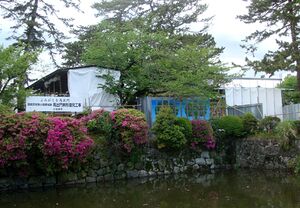- Japanese: 小田原城 (Odawara-jou)
- Type: Flatland-Mountain
- Founder: Omori Yoriharu
- Year: 15c
- Demolished: 1871
- Reconstructed: 1960,1971,1997 (tenshu, gates)
- Location: Sagami province
Odawara was among the most major castles in the Kantô during the Sengoku period, base of the Hôjô clan until its famous fall in the 1590 siege of Odawara.
The base of Odawara castle was a mansion of the Kobayakawa clan in the Kamakura period. The Kobayakawa were replaced by Omori Yoriharu in the Muromachi period. Odawara castle was built by the Omori clan during this time. In 1495, the castle was then taken by Ise Shinkurô (Hôjô Sôun), and the castle was then expanded over five generations of the Hôjô clan. The castle blocked invasions by Uesugi Kenshin (1561) and Takeda Shingen (1569).
In 1590, Toyotomi Hideyoshi mobilized 150,000 troops to Odawara, and besieged the castle for 100 days until Hôjô Ujinao finally surrendered.
Inaba Masaharu, son of Kasuga no Tsubone, became lord of Odawara in 1632, and had the castle renovated, to become more fully an Edo period-style castle. The Ôkubo clan became lords of Odawara shortly afterwards, serving the shogunate in administering Odawara as part of outer defenses for the greater Edo area.[1] The Honmaru palace was maintained only for the shogun's use, should he come to stay at the castle for a time, while the castellan's residence and administrative offices were maintained in the Ni-no-maru palace. Both were surrounded by linked water-filled moats. The Ni-no-maru palace was particularly lavishly appointed in the 1620s-40s, as it was prepared for the 1634 stay of Tokugawa Iemitsu, as he passed through Odawara on his way to Kyoto. The castle suffered considerable damage in a 1703 earthquake, and though the Ni-no-maru palace was reconstructed, it never reached the same heights again. The tenshu collapsed in earthquakes several times in the Edo period, but was reconstructed each time.
Around 1850, the castle-town of Odawara boasted a population of some 12,700 people. Roughly 40% of these were samurai, 14% artisans, 38% merchants, and 8% villagers (peasants). According to some surveys, the descendants of roughly 20% of these people still live in or around Odawara.[1]
Most of the castle's structures, including the tenshu, were demolished by the government in the Meiji period, and public facilities were built. A zoo and amusement park were built in 1950, and reconstruction of the tenshu was completed in 1960. The Tokiwagimon was rebuilt in 1971; other reconstruction efforts are ongoing.
References
- Nihon no Meijo
- Odawara castle official panphlet
- Plaques on-site.

